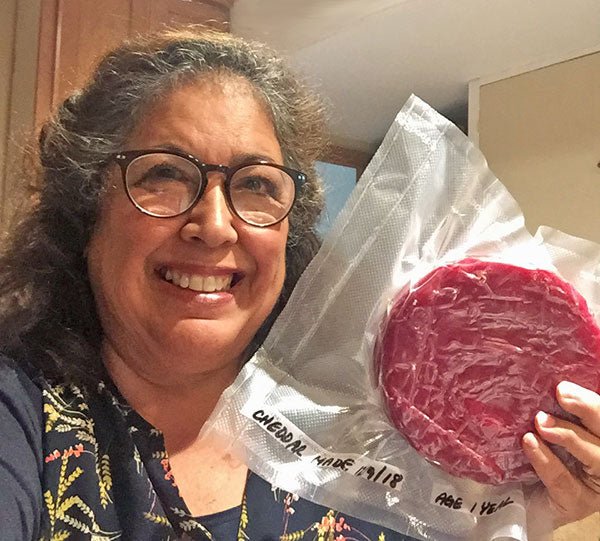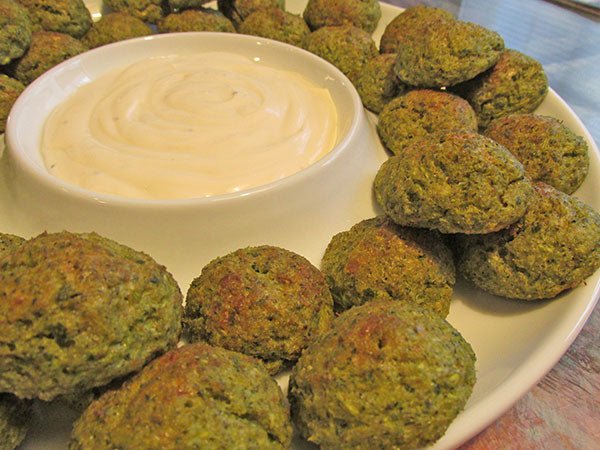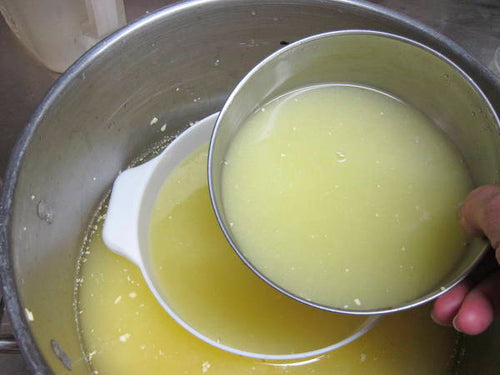
Vivian and her husband, Tom Gory
Vivian Lucero knows a thing or two about making cheese. She seems to have tried every recipe on our website! And, from her pictures, it appears that it all went well.
That’s impressive considering she’s entirely self-taught. She’s hoping someday to take a cheese making class, but we think she might already know enough to teach one!
Vivian’s Story
We live on the Oregon Coast where the climate is wetter and colder than in the Portland area where we moved from. While it’s great for making cheese, gardening here is more challenging and we love to garden as well. Our little garden here consists mostly of a few garden beds and pots for vegetables and herbs and provides all two people need.

We have a sloped wooded property on the river which makes gardening a challenge, not to mention we have lots of hungry deer, raccoons and other critters.

Here we enjoy and harvest the resources of our area. We fish, harvest chanterelles and boletus mushrooms, go clamming and crabbing, pick blackberries and wild huckleberries and shop the
local farmer’s markets in season for the things we cannot grow.

Harvesting wild huckleberries on a sunny, fall day.

Cleaning his chanterelle harvest for the day. He picks and freezes enough chanterelles to last until the next season. Creamy mac & cheese with chanterelles anyone?

If you make cheese, you gotta make bread. Here are loaves of my freshly made cheese bread and Kalamata olive bread.
I have always enjoyed cooking and making everything I could from scratch. We always had a garden and I would either can, freeze, dry or pickle our harvest. My husband makes wonderful fermented pickles. I would make homemade roasted tomato sauce that would last until the next season and we would freeze berries and fruit for baking or making smoothies.
When we lived in Portland, I volunteered for our local food bank in the “learning garden” where we planted and produced thousands of pounds of produce for the food bank every year. We lucky volunteers also got to reap the rewards of our labor. One year I was given one plant each of 27 different varieties of tomatoes. That was a good year for sauce!

How she got started making cheese:
My husband and I retired in May of 2015, and moved from Portland, Oregon to the home his parents built and he grew up in on the Central Oregon coast. I was a florist and dabbled in catering and my husband was in the wine business. Like wine and cheese, we were a match made in heaven.
In January of 2016, we visited a friend in Washington State. There was a small creamery in town and on our way home we stopped to buy some cheese. The room where the cheese was produced had glass walls so you could observe the process. We then tasted a number of their cheeses and took several home. It was right then and there I knew I wanted to make my own cheese now that I had the time. That was the beginning.
As soon as we got home, I immersed myself in Cheese 101. I bought books, I watched just about every You-tube video there was on cheese making. I spent about a month teaching myself the basics of cheese making. I researched sources for milk and supplies then I went crazy buying cheese making supplies when I found your website and another in California. I started with the simple cheeses, like chevre, fromage blanc, mozzarella, ricotta etc. They were all a hit with our friends and family.
I then dared to step out of my comfort zone and make molded cheeses. At first, I mostly used the recipes from Artisan Cheese Making at Home because they were small batches and if
something went wrong, it wasn’t a big loss – just the cost of learning. I read the book cover-to-cover then I actually created a spreadsheet as a quick reference guide with most of the cheeses in the book.
I included the name of the cheese, the page number for the recipe, yield, type of milk, cultures and mold shapes and sizes and time to make and age the cheese. That way I could decide to make a cheese that only took a short time to make or to age without going through the entire book looking for just the right cheese to make. I didn’t want to start off making cheese that took 6 months to a year to age. I didn’t want to wait that long to learn it was a failure. It also served as a quick reference for making different cheeses using the same cultures I had on hand. It was quite a laborious task but in the end it was a big time saver and I still use it today.
I made my first molded cheese on February 18, 2016. That was the beginning of my cheese making.

My Stilton
My husband was in the wine business for 35 years and when I told him I needed to buy a cheese press, he said, I think I have something you can use. It’s an old grape press. I love it; it
works well!


I use a two-part wine cooler for my cheese cave. It works great! I store my blues in the upper compartment and the rest in the lower compartment. Since we live in a very cool climate with high humidity, I have also been known to store cheese in a camp cooler outside and in our bbq (in winter) when the cheese cooler is full. That’s actually what I used before we bought the wine cooler. It worked well and kept the cheese safe from critters like raccoons.

This is where I store some of my cheese supplies and cooler. Cooler is on bottom, basket organizer holds supplies like cheese cloth, cheese wrappers, wax etc. and on top is my cheese press. Lots more stuff is tucked away here and there.
Cheeses she has made:
Since making cheese, I have made many of the soft, quick cheeses; fromage blanc, chevre, mozzarella, ricotta. I have made halloumi cheese for a friend of ours from Turkey. I was quite surprised by it’s taste and texture and non-melting quality. I fried it and served it with a drizzle of olive oil and it was delicious.

Manchego. It was good but I could have aged it longer.
The first molded cheese I made was a brew curd cheddar. My husband and I went to a local microbrew pub one day for lunch. He knows the brew master and they were talking about some of
the newer beers he was making. One of them was an Oatmeal Stout beer. On came the light bulb and I decided to make brew curd cheddar with his beer.

Brew curd cheddar with Rogue Brewing Oatmeal Stout after pressed and dried. It actually came out pretty good for my first pressed cheese.
Here is a picture of my latest white cheddar curd.

It’s part of the series with my cheese press in use pressing the cheddar curds. That recipe is from the Gavin Webber (Certified Cheese Nerd from You-tube Cheeseman TV). I learned most of my cheese making techniques just watching almost all of his videos when I first started making cheese. I love this guy! He’s really fun! I have this cheese in my cooler now. I waxed and also vacuumed sealed it. It won’t be ready until October or later. I made it in December.
One of my favorite cheeses to make is St. Marcellin. I have made it a number of times and it always comes out great.

St. Marcellin in the making.

St. Marcellin right out of the molds.

St. Marcellin blooming and ripening.

St. Marcellin tasting. I just love this cheese. It’s my favorite to make and popular with everyone who tries it. Sometimes I add a little lipase to get a bit stronger flavor.
On that note, I want to tell you about a similar cheese – Mont d’ Or cheese. I decided one day to make it when I found it on your website. I told my husband and our friend Frank (our cheese caretaker when we travel) about this cheese that was supported by a thin layer of spruce cambium. Like two kids who love to play in the woods, these two decided they were going to cut down a small spruce tree and harvest the cambium layer for my Mont d’ Or cheese. After all, we live in spruce country and Frank has acres and acres of spruce on his property. So, they came back with these strips of spruce cambium and I dried them and used them to make the cheese. What an adventure it was!

Mont d’Or ready for aging.
I also have the new Cardoona cheese from the recipe that Jim came up with recently.

Cardoona in the making.
I was so excited to see Cardoona in the newsletter right after we came back from Portugal in October. We had eaten the most amazing cheeses made of cardoon rennet and sheep’s milk. I immediately ordered the thistle rennet from your website and decided to make it.

This was a little “cheesy” happy hour we had with friends to try some of my cheeses. Back left is Buttermilk Blue from Artisan Cheese Making at Home; back right is the spruce banded Mont d’Or. Forward left is a Reblochon from your website and forward right is the finished brew curd cheddar. When you have that much cheese, you must share it!
My biggest challenge where we live is sourcing the milk. We live near Tillamook county where the famous Tillamook Cheese Factory is. Even so, I haven’t found a source for raw cow’s milk but I do get a good quality pasteurized milk from a Tillamook dairy that delivers to our area. I have two local sources for raw goat’s milk and had the pleasure of bottle feeding a six day old kid when picking up some of his mama’s milk.

I did find a source for sheep’s milk three hours away in Washington. I may just go up there this spring and try making real Portuguese cheese with your thistle rennet.
Advice for future cheese makers:
Don’t be afraid to make mistakes, because you will. Cheese is magical. As Anthony Bourdain once said, “You have to be a romantic to invest yourself, your money and your time in
cheese.” So I am.















































































































































